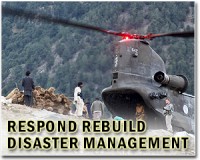| . |  |
. |
Paris, France (SPX) Feb 24, 2011 When a major disaster strikes in remote parts of the world, knowing if the area is populated, and how densely, is crucial for the effective organisation of humanitarian operations. The Global Human Settlements Layer (GHSL), developed by the European Commission's Joint Research Centre (JRC), will soon provide this detailed information for the first time on a global scale. The breakthrough is new advanced algorithms, developed by the JRC, that allow automatic analysis of medium resolution data provided by European satellites. The first test results confirm that the combined use of ICT technologies permit fast and precise mapping of built-up areas, anywhere in the world. In addition, the algorithms allow massive datasets to be processed more efficiently and rapidly, making it possible to monitor the changes in human settlements regularly and equally importantly, to collect the same information from heterogeneous satellite data. This can help to reduce risks in areas that experience recurrent disasters and to focus post-disaster humanitarian interventions on the most likely populated places in disaster affected countries and regions. The European Commission's Joint Research Centre, in collaboration with the European Space Agency's (ESA) Earth Observation Ground Segment Department (EOP-G) has produced the first prototype of a new Global Human Settlement Layer (GHSL) using European radar satellite (ENVISAT) capacity and advanced automatic pattern recognition algorithms. One of the major problems in disaster-struck areas in less developed countries is the lack of relevant and up to date pre-disaster information that can help to quickly locate and assess the type and extent of damage, especially in populated places. The GHSL will help to focus damage analysis very quickly over populated places, leading to improvements in emergency rescue and humanitarian relief operations. The GHSL will help to improve the quantification of the building stock which is valuable information both for risk assessment activities and for emergency rescue operations. As the building stock is an indicator of human presence, this critical piece of information on population (often lacking in remote areas) can help the first responder communities to focus their efforts in a particular area.
Human settlements in Africa - successful test of JRC's algorithms The inferential system successfully classified about 4 billion image elements related to 270 scenes pertaining to the ENVISAT ASAR sensor provided by the European Space Agency (ESA). The results confirm notable expected improvements using 75m resolution data processed by means of the JRC's method over already available human settlement data. These previous data were produced from 500m resolution data of the US MODIS or Moderate Resolution Imaging Spectro-radiometer instrument aboard the Terra EOS satellite and of the Defense Meteorological Satellite Program (DMSP) Operational Linescan System (OLS) data at 3 km resolution. During 2011, the rest of the global landmass will be processed by the JRC using available European radar satellite capacity in order to complete the production of the first ever global human settlement layer. Moreover, the GHSL concept has an open and scalable design based on semantic interoperability and consistent multi-scale reasoning. This means that heterogeneous platforms, including existing and planned optical and radar sensors can contribute to refining the overall GHSL picture in a consistent manner.
The added value of geo-spatial information for crisis management in an urban world The combined use of better spatial resolution satellite data and of an automatic pattern recognition algorithm means that we can now process massive datasets more efficiently and rapidly than ever before. It also allows regular monitoring of the changes in the patterns of human settlement landscape anywhere in the world. These advances also imply that we are able to potentially look at human settlement characteristics and patterns in more detail than previous global analysis attempts.
Share This Article With Planet Earth
Related Links Joint Research Centre at EU G-POD at ESA Bringing Order To A World Of Disasters A world of storm and tempest When the Earth Quakes
 Hopes for survivors fade in quake-hit Christchurch
Hopes for survivors fade in quake-hit ChristchurchChristchurch, New Zealand (AFP) Feb 24, 2011 A 'miracle' was required to find more survivors amid the wreckage of earthquake-hit Christchurch, Prime Minister John Key said Thursday, as the focus turned to recovering bodies. Two days after the 6.3-magnitude quake flattened buildings in New Zealand's second city, police said there had been no communication with people trapped inside the rubble for 24 hours, reducing the chances of findin ... read more |
|
| The content herein, unless otherwise known to be public domain, are Copyright 1995-2010 - SpaceDaily. AFP and UPI Wire Stories are copyright Agence France-Presse and United Press International. ESA Portal Reports are copyright European Space Agency. All NASA sourced material is public domain. Additional copyrights may apply in whole or part to other bona fide parties. Advertising does not imply endorsement,agreement or approval of any opinions, statements or information provided by SpaceDaily on any Web page published or hosted by SpaceDaily. Privacy Statement |